Kombucha Journal
Online since 30 years. Founded 1996 by Günther W. Frank
How to make your own Kombucha-Tea
|
|
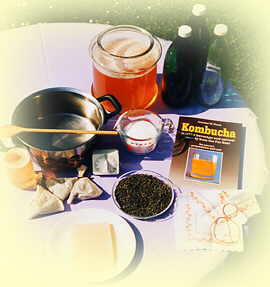
|
Ingredients
Utensils and materials
|
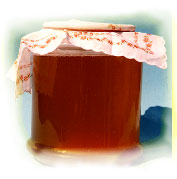
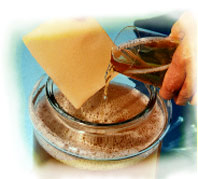
It's best if you begin first with two litres (2 quarts). When your Kombucha culture has grown big enough and has reproduced itself, you can produce larger quantities of the beverage.
1. - Make tea in the ordinary way. Per litre (quart ) of water, infuse 2 teaspoonfuls (about 5 g = 0.2 oz) of black or green tea in freshly boiled water. You may also use tea bags. Let the tea leaves "soak" for 15 minutes. Green tea comes from the same plant as black tea and is distinguished from it principally by the way it is processed: it is not fermented. Japanese doctors found out that green tea prevents cancer growth. I would suggest to use green tea for the Kombucha beverage. If you don't want to use black or green tea you can also use herbal teas.
2. - Strain off the tea leaves through a sieve, or remove the tea bags from the water, as the case
may be.
3. - Add about 70 - 100 g (2 - 3 oz) of white sugar per litre (quart) of water into the filtered infusion before it has cooled. Stir the tea so that the sugar dissolves totally. 1 tablespoon of sugar is
about 20 g (0.7 oz).
4. - Let the sugared tea cool down to a temperature not higher than 20° - 25° Centigrade = about 68° - 77° Fahrenheit (lukewarm). The culture dies when it has been placed in a hot nutrient solution.
 5. - When the tea has cooled to room temperature, pour the solution into a glass, china, glazed earthenware or stainless steel container. Glass is best.
Metal containers of other types than stainless steel are unsatisfactory and should never be used because the acids formed may react with the metal. You could also use a high-grade synthetic material of the polylefine group, e.g. polyethylene (PE) or polypropylene. Wine or cider is also kept in containers made of this food-grade material. However, you should avoid containers made of polyvinylchloride (PVC) or polystyrene.
5. - When the tea has cooled to room temperature, pour the solution into a glass, china, glazed earthenware or stainless steel container. Glass is best.
Metal containers of other types than stainless steel are unsatisfactory and should never be used because the acids formed may react with the metal. You could also use a high-grade synthetic material of the polylefine group, e.g. polyethylene (PE) or polypropylene. Wine or cider is also kept in containers made of this food-grade material. However, you should avoid containers made of polyvinylchloride (PVC) or polystyrene.
6. - If you prepare your first Kombucha drink, add the liquid that you got with the culture. On all later batches, always keep enough Kombucha drink to add about one tenth (10%) of the quantity to your new batch as a "starter liquid".
7. - Place the live Kombucha culture in the liquid.
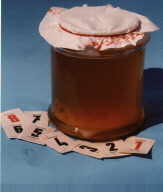 8. - Cover the mouth of the fermentation container with a tightly woven fabric, a tea towel, paper towel or similar light cloth to keep out fruit flies, dust, plant spores and other pollutants. Tie it down with a large rubber band to ensure that fruit flies can't get in. The cloth must be porous enough to allow air to circulate so the culture can breathe, but not so porous that tiny fruit flies can get in to lay their eggs.
8. - Cover the mouth of the fermentation container with a tightly woven fabric, a tea towel, paper towel or similar light cloth to keep out fruit flies, dust, plant spores and other pollutants. Tie it down with a large rubber band to ensure that fruit flies can't get in. The cloth must be porous enough to allow air to circulate so the culture can breathe, but not so porous that tiny fruit flies can get in to lay their eggs.
9. - The fermentation should proceed for 8 - 12 days, depending on the temperature. The higher the room temperature, the faster the fermentation. The period of 8 - 12 days is given merely as a guide.
The Kombucha culture needs a warm and quiet place and should on no account be moved. The temperature of the tea should not fall below 68°F (= 20° Centigrade). The ideal temperature is about 74°F - 85°F (=23° - 29° C). Light is not necessary. The culture also works in darkness. The culture may be damaged by exposure to bright sunlight. Half shade is better.
Kombucha Heating Trays (click for more information)
During the process of fermentation the sugar is broken down by the yeast and converted into a gas (CO2) and various organic acids and other compounds. It is the combination of these processes which gives the Kombucha beverage its characteristic flavor.
The infusion is at first sweet but this sweetness disappears as the sugar is broken down. At the same time an acid flavor begins to develop as a result of the activities of the bacterium, so there is a transition from sweetness to sourness. If a slightly sweet drink is preferred, the fermentation has to be stopped earlier. For a dry or slightly acid flavor it has to be continued longer.
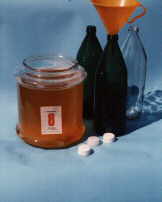 10. - When the tea has attained the right acid degree (pH 2,7 - 3,2), depending on individual taste, remove the culture with clean hands. Clean the culture under cold or lukewarm water. Fill new tea into the jar and add the culture immediately. Respect the right temperature of the tea.
10. - When the tea has attained the right acid degree (pH 2,7 - 3,2), depending on individual taste, remove the culture with clean hands. Clean the culture under cold or lukewarm water. Fill new tea into the jar and add the culture immediately. Respect the right temperature of the tea.
Pour the beverage into bottles, which should be filled to the brim. Keep about one tenth (10%) as starter for the next batch. Stopper the bottles securely. I don't think it necessary to strain the fermented beverage through a cloth. A certain amount of sediment is normal. It is due to the growth of yeasts, which produced the gas which aerates the beverage. The yeasts are said to have some desirable positive effects on the human organism.
11. - To find ultimate satisfaction in this drink it should be allowed to mature for a few days (at least 5 days), after having been bottled.
The activity of the bacterium is stopped because the bottling excludes the air, while the yeast continues to work. If the bottles are securely stoppered, the gas produced by the yeast's activities, is unable to escape. Thus an effervescent drink is produced. For this a few days in the bottles is usually sufficient; the Kombucha beverage, however, will keep well for months. Do not worry: The yeast will stop the gas production at a certain point. It is advisable to keep the beverage in a cool place.
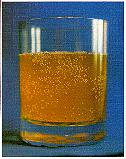 12. - The drink has an agreeable taste. It is sparkling, slightly sour and refreshing. One normally drinks three glasses a day, one glass (0.1 litre/quart or more) on an empty stomach in the morning, the second glass after a meal in the course of the day, and the last glass a short time before going to bed. Enjoy!
12. - The drink has an agreeable taste. It is sparkling, slightly sour and refreshing. One normally drinks three glasses a day, one glass (0.1 litre/quart or more) on an empty stomach in the morning, the second glass after a meal in the course of the day, and the last glass a short time before going to bed. Enjoy!
13. - When you start a new fermentation process, never forget to add to the new tea at least 10 % of the liquid from a cultivation which has already fermented.
Some recipes in the USA call for one cup. What size does this mean? The standard measuring cup used in recipes is based on 8 fluid ounces = 1 cup. An alternative metric measure would be 8 ounces = 250 ml. An alternative would be to weigh sugar etc., in that case 8 oz = 226.80 grams.
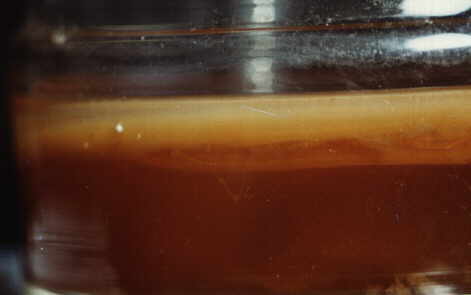
If you have any problems with growing new Kombucha babys (which sometimes occur when it is too cold, e.g. in winter), you may try this: Because the growing of a new culture needs more time you should separate it from the preparation of the beverage that you want to drink. Please allow the new culture on the surface of the liquid 3 to 5 weeks to grow.
 The Kombucha culture grows and covers the surface of the tea completely. While growing on the surface of the tea the culture thickens considerably. The thickened culture will be composed of easily separable superimposed layers. The layers can be peeled off one from another and each can be used as independent units for the production of Kombucha beverage. If the culture should sink to the bottom of the vessel, a new culture will form on the surface of the tea.
The Kombucha culture grows and covers the surface of the tea completely. While growing on the surface of the tea the culture thickens considerably. The thickened culture will be composed of easily separable superimposed layers. The layers can be peeled off one from another and each can be used as independent units for the production of Kombucha beverage. If the culture should sink to the bottom of the vessel, a new culture will form on the surface of the tea.
In this way each culture will continue to propagate itself until it gradually begins to turn a dark brown color. When it is dark and dirty brown discard it and replace it with one of its offspring. Thus this unique culture can provide you, your family and your friends with an ongoing supply of Kombucha tea at very low cost.
 Time and again I'm asked the same questions: "Why do you need so much sugar? And why do you have to let the tea brew for 15 minutes, when normally 5 minutes is enough at the most?". These subjects are dealt with in detail later on, so for the moment, simply and briefly:
Time and again I'm asked the same questions: "Why do you need so much sugar? And why do you have to let the tea brew for 15 minutes, when normally 5 minutes is enough at the most?". These subjects are dealt with in detail later on, so for the moment, simply and briefly:
The nutrient solution has to feed the micro-organisms in the Kombucha culture, not us. We must therefore prepare the nutrient solution according to the requirements of the yeasts principally (the bacteria feed in their turn partly on the nutrient solution itself). The micro-organisms need the sugar in order to become activated. In nutrient solutions with a low concentration of sugar (carbohydrate), correspondingly fewer active substances are released. In lay terms, the sugar is "eaten" by the yeasts.
The tea infusion, on the other hand, serves as a source of nitrogen and promotes the growth of the micro-organisms. So that as much of this nitrogen as possible passes into the nutrient solution, as well as mineral salts, etc., a rather longer time than usual is recommended for brewing the tea. The Russian research scientist Danielova (1959) even went so far as to boil the tea for 3 to 5 minutes, presumably for the same reason.
 Source:
Source:
Kombucha - Healthy Beverage and Natural Remedy from the Far East
By Günther W. Frank
ISBN 3-85068-337-0
Published by
W. Ennsthaler, A-4402 Steyr, 1995
Where to get Günther's book.
Günther's book goes into considerable detail and includes many references.
It is an excellent book that is the result of many years of studying Kombucha.
I think this book is the original source of much of the current information
on Kombucha.
See the index of the book
and also where to buy the book.
News
new Kombucha mailing lists 17 Dec 2020
exchange with other people about Kombucha. ... more
The future of kombu.de 07 Mar 2019
The site continues to be an independent and uncommercial service ... more
kombu.de is online again 05 Mar 2019
Günther W. Frank hands over the Kombucha Journal to Felix Böttcher ... more